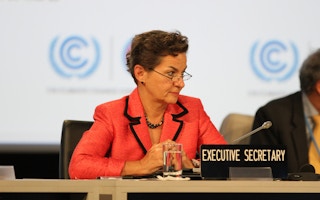An international goal of providing $100 billion each year by 2020 to help vulnerable countries adapt to climate change impacts and pursue green growth is far off what is needed to achieve a global clean revolution, the UN’s top climate change official said on Wednesday.
Christiana Figueres told journalists at UN climate talks in Lima that in terms of paying for the efforts needed to shift economies worldwide onto a low-carbon track “$100 billion is frankly a very, very small sum”.
“We are talking here about trillions of dollars that need to flow into the transformation at a global level,” she added. She said $90 trillion would be invested in infrastructure over the next 15 years.
“The world needs to decide: Are those $90 trillion going to go into clean technology, clean infrastructure, and above all resilient infrastructure, or or is it going to go into the technologies and infrastructure of the last century?”
Climate finance is in the spotlight at the two-week negotiations in Peru, as developing countries push for more clarity on how to drive funding up to the $100 billion level governments committed to back in 2009.
Finance is seen as key to building trust between richer and poorer nations at the talks.
“
The world needs to decide: Are those $90 trillion going to go into clean technology, clean infrastructure, and above all resilient infrastructure, or or is it going to go into the technologies and infrastructure of the last century?
Christiana Figueres, executive secretary of the United Nations Framework Convention on Climate Change
A voluntary accord agreed at the 2009 Copenhagen summit said the money should come from “a wide variety of sources”, including public and private funds, bilateral and multilateral funds and other “alternative” sources of finance.
One problem to date is that there has been little understanding of how much funding is flowing, what kind, and from where to where. That has hampered progress on working out a clear pathway to ramping it up.
A new look at the numbers
The United Nations climate change secretariat presented a report on Wednesday aimed at throwing some light on the money that has already been provided.
The assessment report - the first putting together information and data on financial flows for emission reductions and adaptation within countries as well as via international support - said public and private flows from developed to developing countries ranged from $40 to $175 billion a year between 2010 and 2012.
This included annual flows of $35-50 billion through public institutions, and $5-$125 billion of private finance, it said.
Those numbers suggest the world may not be as far off track in meeting the $100 billion goal as previously thought.
But Figueres said countries still needed to agree what part of the climate finance flows identified in the report could be counted towards the $100 billion.
There are differing views, for example, on the balance between public and private funding, with some developing countries arguing the bulk of the goal should be delivered from public sources.
Figueres described the $100 billion as a “numerical proxy” for the trust developing countries need to have that funding for their climate change activities is actually coming forward.
Governments at least have numbers they can work with now, which should help “puncture many myths”, she noted.
“I would say a very good start, but only a start,” she added.










